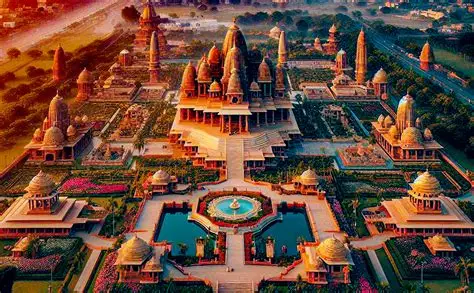Places to Visit in Ayodhya: A Spiritual and Cultural Odyssey

Ayodhya, one of the seven sacred cities in Hinduism, is steeped in mythology, history, and devotion. The places to visit in Ayodhya offer a rich tapestry of spiritual landmarks, ancient temples, serene ghats, and cultural heritage that make it a must-visit destination for pilgrims, history buffs, and curious travelers alike.
Whether you're drawn by faith, fascinated by epic tales, or simply seeking peace by the Sarayu River, Ayodhya welcomes you with timeless grace.
🛕 Top 15 Places to Visit in Ayodhya
Here’s a curated list of the most iconic and meaningful sites to explore in this sacred city:
1. Ram Janmabhoomi
The most revered site in Ayodhya, believed to be the birthplace of Lord Rama.
-
Highlights: Grand Ram Mandir, spiritual ambiance, daily aarti.
-
Experience: Witness the architectural marvel and participate in devotional rituals.
2. Hanuman Garhi Mandir
A fortress-like temple dedicated to Lord Hanuman, located atop a hillock.
-
Must-See: 76 steps leading to the shrine, panoramic views of Ayodhya.
-
Experience: Devotees believe visiting Hanuman Garhi is essential before Ram Janmabhoomi.
3. Kanak Bhawan
A beautiful temple gifted to Sita by Kaikeyi, showcasing intricate architecture and idols of Ram and Sita.
-
Highlights: Ornate interiors, vibrant murals, spiritual serenity.
-
Experience: Peaceful darshan and storytelling sessions.
4. Dashrath Bhavan
Believed to be the royal residence of King Dashrath, father of Lord Rama.
-
Must-Visit: Historical significance, devotional atmosphere.
-
Experience: Engage with priests and learn about Ramayana lore.
5. Nageshwarnath Temple
Dedicated to Lord Shiva, this temple is said to have been established by Kush, son of Lord Rama.
-
Highlights: Ancient architecture, Shivratri celebrations.
-
Experience: Spiritual calm and cultural immersion.
6. Sita Ki Rasoi
A symbolic kitchen believed to be used by Sita after her marriage to Lord Rama.
-
Must-See: Traditional utensils, temple rituals.
-
Experience: A unique blend of mythology and domestic heritage.
7. Ram Ki Paidi
A series of ghats along the Sarayu River, ideal for rituals, bathing, and evening aarti.
-
Highlights: Sunset views, Deepotsav celebrations.
-
Experience: Participate in holy dips and witness the river come alive with lamps.
8. Treta Ke Thakur
A temple believed to house idols installed by King Vikramaditya, commemorating Lord Rama’s Ashwamedha Yagna.
-
Must-Visit: Rare darshan opportunities, historical depth.
-
Experience: Visit during Kartik month for special rituals.
9. Guptar Ghat
Associated with Lord Rama’s final departure from the mortal world.
-
Highlights: Peaceful riverbank, spiritual significance.
-
Experience: Ideal for meditation and quiet reflection.
10. Raj Dwar Mandir
One of the oldest temples in Ayodhya, known for its unique architecture and spiritual ambiance.
-
Must-See: Intricate carvings, quiet surroundings.
-
Experience: A hidden gem for those seeking solitude.
11. Bharat Kund
Located in Nandigram, this site is associated with Lord Bharat’s penance during Lord Rama’s exile.
-
Highlights: Sacred pond, temple complex.
-
Experience: Learn about the lesser-known chapters of Ramayana.
12. Tulsi Smarak Bhawan
Dedicated to Goswami Tulsidas, the author of Ramcharitmanas.
-
Must-Visit: Museum, library, cultural programs.
-
Experience: Attend Ramayana recitations and literary events.
13. Ram Katha Park
An open-air venue for religious and cultural performances.
-
Highlights: Ramayana plays, devotional music.
-
Experience: Visit during festivals for vibrant shows.
14. Gulab Bari
A Mughal-style garden and tomb complex associated with Nawab Shuja-ud-Daula.
-
Must-See: Rose gardens, Indo-Islamic architecture.
-
Experience: A peaceful contrast to Ayodhya’s temple trail.
15. Imambara
A reflection of Ayodhya’s secular heritage, showcasing Shia Muslim architecture and traditions.
-
Highlights: Historical significance, cultural diversity.
-
Experience: Explore Ayodhya’s pluralistic past.
Sources:
🎉 Festivals and Events in Ayodhya
Ayodhya’s spiritual energy peaks during festivals:
-
Deepotsav: Thousands of diyas light up Ram Ki Paidi during Diwali.
-
Ram Navami: Celebrates Lord Rama’s birth with processions and prayers.
-
Kartik Purnima: Holy dips and rituals at Sarayu River.
-
Makar Sankranti: Kite flying and community feasts.
🛍️ What to Buy in Ayodhya
Take home a piece of Ayodhya’s soul:
-
Ramayana-themed souvenirs: Books, idols, scrolls.
-
Handicrafts: Brassware, wood carvings, religious décor.
-
Prasad & Sweets: Pedas, laddoos, and temple offerings.
🍛 Where to Eat
Ayodhya offers simple, sattvic meals and local flavors:
-
Sita Rasoi Bhojnalaya: Temple-style vegetarian thali.
-
Local dhabas: Kachori-sabzi, poha, and chai.
-
Sweet shops: Try peda, khurchan, and rabri.
🏨 Where to Stay
Options range from budget lodges to spiritual retreats:
-
Dharamshalas: Affordable and close to temples.
-
Heritage stays: Experience royal hospitality.
-
Hotels: Comfortable options near Ram Janmabhoomi.
📅 Best Time to Visit Ayodhya
-
October to March: Pleasant weather and festival season.
-
April to June: Hot but ideal for early morning temple visits.
-
July to September: Monsoon greenery and fewer crowds.
✈️ How to Reach Ayodhya
-
By Air: Maharishi Valmiki International Airport (opening soon).
-
By Train: Ayodhya Junction and Faizabad Station.
-
By Road: Well-connected via NH27 and NH330.
🧭 Travel Tips
-
Dress modestly and respectfully at religious sites.
-
Carry water, sunscreen, and ID.
-
Book accommodations early during festivals.
-
Engage with local guides for deeper insights.
Ayodhya is more than a city—it’s a living epic. The places to visit in Ayodhya offer a journey through devotion, history, and timeless storytelling. Whether you’re tracing the footsteps of Lord Rama or simply soaking in the spiritual ambiance, Ayodhya leaves you transformed.
Let the chants echo in your heart, let the river cleanse your thoughts, and let Ayodhya become your story.




